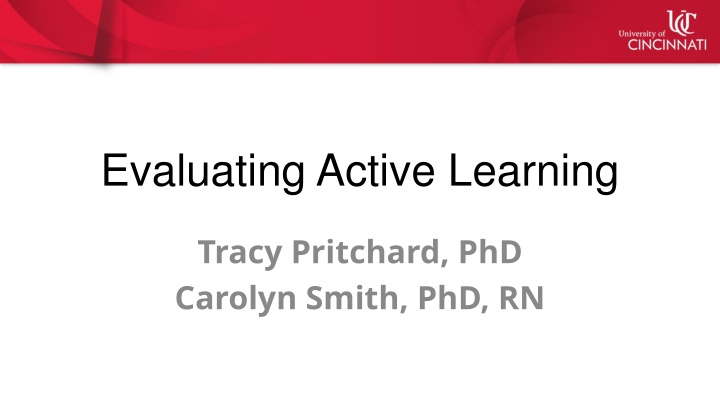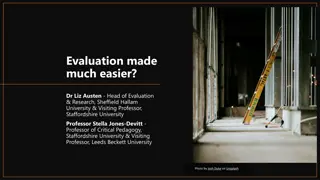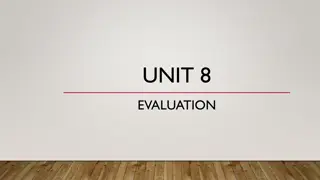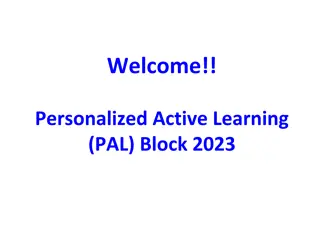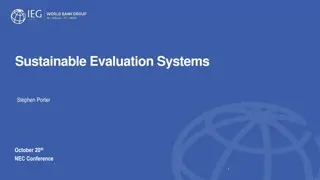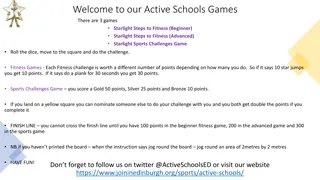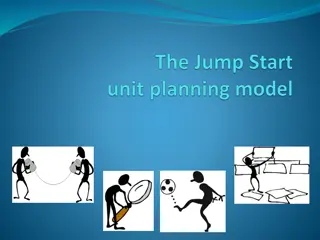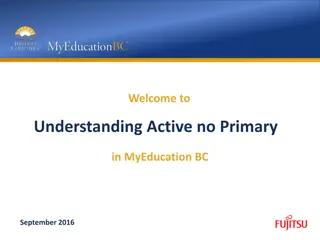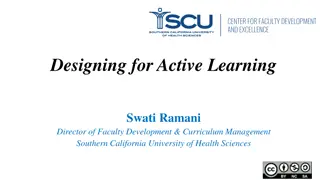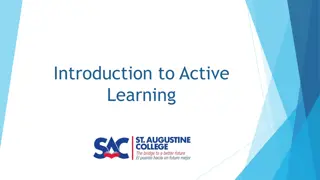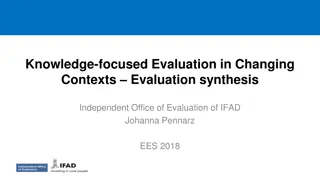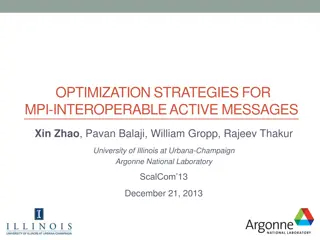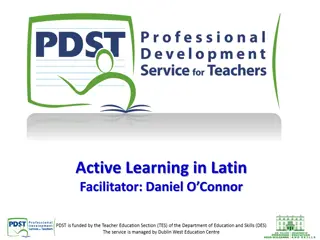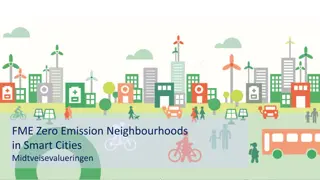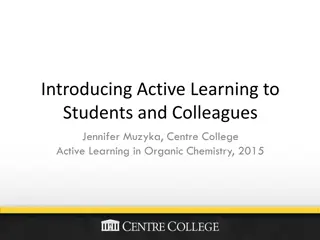The Evaluation of Active Learning Strategies
Explore the diverse aspects of evaluating active learning, from defining levels of engagement to identifying facilitators and barriers to implementation. Discover methodologies, outcomes, and tips to assess the effectiveness of active learning strategies in educational settings.
Download Presentation

Please find below an Image/Link to download the presentation.
The content on the website is provided AS IS for your information and personal use only. It may not be sold, licensed, or shared on other websites without obtaining consent from the author.If you encounter any issues during the download, it is possible that the publisher has removed the file from their server.
You are allowed to download the files provided on this website for personal or commercial use, subject to the condition that they are used lawfully. All files are the property of their respective owners.
The content on the website is provided AS IS for your information and personal use only. It may not be sold, licensed, or shared on other websites without obtaining consent from the author.
E N D
Presentation Transcript
Evaluating Active Learning Tracy Pritchard, PhD Carolyn Smith, PhD, RN
Learning Objectives Define the degrees of active learning Discuss different approaches to evaluating active learning Outline facilitators and barriers to evaluating use of technology in active learning strategies Share lessons learned from evaluating implementation of active learning strategies
Active Learning-What IS it? Log into Socrative.com Select Log-in Click on Student Log-in Enter room 447594
Active Learning-What is it? Methods that engage students in the learning process Students required to think about the meaning of learning activities Degrees of active learning Low, Moderate, High complexity Alignment with Blooms Revised Taxonomy Intention behind strategies selected
Why does this matter for you? Unmute and share
How do we know if active learning is making a difference?
Outcomes Associated with Active Learning Engagement Satisfaction Performance Grades Application of content
Tips Identify what active learning strategies you are evaluating Identify goal you are trying to achieve using that active learning strategy Determine your audience for evaluation: students, faculty or both
Active Learning Inventory Van Amburgh et al, 2007. American Journal of Pharmaceutical Education. 71(5) Developed an inventory to measure the type, amount, length and complexity of active learning Aimed to assess the breadth and depth of strategies were used Good resource for identifying appropriate active learning strategies aligned with the level of complexity of thinking required by the learner (Bloom s taxonomy)
Preconception Check Socrative Activity List active learning strategies you know or have heard of
Complexity Active Learning Strategy Description Question and Answer Students orally respond to a question, comment, etc. either voluntarily or by cold calling. One Minute Paper/Focused Listing/One Sentence Summary Short writing task designed to allow students to focus attention on a single important item, name, or concept from a particular lesson/session. Short, individual written response to a prompt/ question, then instructed to share and discuss briefly with partner, then asked to share with larger group. Think/Pair/Share Brain Dump/Free Write Short write in which students write down everything they know about an announced topic. At some point during or after an in-class presentation, students write a quick response to the prompt, What was the muddiest point in __? Muddiest Point Low Misconception/ Preconception Check Complexity Simple technique for gathering information on what students perceive they already know. Application Activity Written activity in which students apply 1-2 principles and concepts in real life situation. Students create questions for quizzes of exams that are crafted to capture central elements in the course. Student-Generated Questions Formative Quizzes/ Surveys Ungraded quizzes/ surveys to determine comprehension. Students participate in lecture by responding to questions/statements via computers/ wireless technology. Personal Response System Self/Peer Formative Assessments Activities that require students to assess performance against applicable criteria; extend to offer specific suggestions for improvement. Adapted from Van Amburgh et al, 2007. American Journal of Pharmaceutical Education. 71(5)
Complexity Active Learning Strategy Description Small Group Presentations/Discussions Presentations/discussions of course material. Students and/or faculty performing specific roles for demonstration purposes. Simulations/games include guiding principles, specific rules and structured relationships. Role Playing/Simulations/Games Students are presented with 2-3 important categories along with scrambled subordinate terms, images, equations or other items that belong in one or another of the subordinate categories. Categorizing Grid/Pro-Con Grid Moderate Complexity Defining Features Matrix/Memory Matrix Students categorize concepts presented according to presence/absence of defining features. Debates Small or large group structured exploration of central concepts, data, beliefs, values. Peer Teaching Students teaching each other basic and/or intermediate levels of course materials or needed skills. Drawings or diagrams that show the mental connections that students make between a major concept presented and other concepts they have learned. Concept Maps Cases Scenarios that require students to integrate their skills to solve problems that relate to course materials. Scenario-based problem-solving activity using small groups to tackle specific questions/issues from larger list. Cooperative Cases High Team-based: each member becomes subject matter expert in 1 or 4 areas selected from current course material. Each member teaches their subject matter. Complexity Jigsaw Cooperative Learning/ Problem Based Learning Students work together to learn course knowledge and to develop course skills. Adapted from Van Amburgh et al, 2007. American Journal of Pharmaceutical Education. 71(5)
Active Learning in Online Environment Novice Focus on low to moderate complexity activities Consider using discussion boards and quiz functions in LMS Use WebEx (live) or Kaltura (pre- recorded) group-led learning and presentations Tech-Savvy Can use any level of complexity activity Student group work via LMS Tools such as WebEx and Teams Flipgrid for engaging students in debate/discussion
Practicality of Active Learning How do you do this? Activity-- We will assign each person to a breakout room Identify a learning objective from one of your classes What level of blooms is this focused on? Looking at the Active Learning Inventory, what type of activities could match well with this learning objective? How might you go about applying that activity? How could this activity be delivered online? There is a link to the Bloom s Taxonomy and the Active Learning Inventory resources and a learning activity template being shared in the chat box.
Lesson Learned Do an initial survey of your class What active learning strategies have you implemented What technology are you using Compare to what active learning strategies and technological tools students perceive to be used for your class
Examples of Alignment/Misalignment Between Active Learning Strategies Used from Faculty Vs. Student Perspective
Findings from an Active Learning Survey from College of Nursing Top 3 Active Learning Strategies from the Faculty Perspective (n=8) Question and answer Formative quizzes Small group presentations Top 3 Active Learning Strategies from the Student Perspective (n = 73) Field experience/learning practicum Concept maps Question and answer
Findings from Active Learning Survey Top 4 Active Learning Strategies that incorporated the iPad from the Student Perspective (n = 73) Top 3 Active Learning Strategies that incorporated the iPad from the Faculty Perspective (n=8) Formative quizzes (85%) Think pair share (75%) Peer teaching (80%) Peer teaching (50%) Concept maps (78%) Concept maps (50%) Think pair share (77%)
Rapid Cycle Quality Improvement What are we trying to accomplish? How will we know if a change is an improvement? What changes can we make that will result in improvement? -Thomas Nolan, PhD
Ethical Considerations Undue influence and manipulation Voluntariness Confidentiality vs anonymity IRB review Quality improvement vs. research involving human subjects
Lessons Learned Engage stakeholders early in the process (be inclusive) Define your goal or purpose for implementing the education intervention Identify strong advocates for the project Develop an evaluation plan before implementation Need to collect baseline information What will you use to compare your outcomes? How will you know the intervention worked or did not work?
Change is the end result of all true learning. Leo Buscaglia
